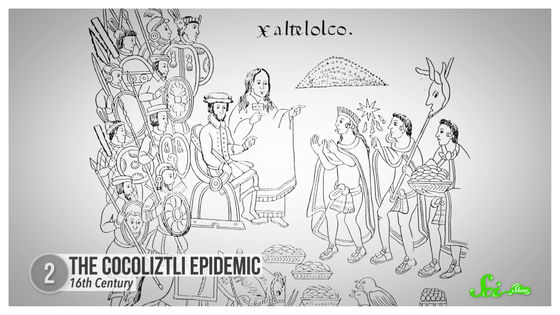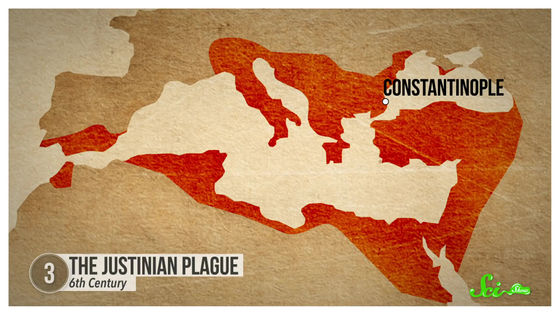What are the six mysterious outbreaks in human history?

Stefan Chin of the science-based YouTube channel
6 Mysterious Ancient Outbreaks-YouTube
◆ 1: Mass death of the Wampanoag tribe (17th century)
The Wampanoag tribe is one of the Indian tribes living in Massachusetts in the northeastern United States.

Between 1616 and 1619, many Wampanoag villages were destroyed, and 30-90% of the Wampanoag tribe, which was said to have been around 20,000 in the early 17th century, was sick.

According to reports at the time, the victims had yellowing of the skin, fever, and severe nosebleeds.

According to Chin, smallpox, influenza,

Meanwhile, ' leptospirosis ' is considered to be the most probable cause of the death of the Wampanoag tribe. This is a disease caused by a coil-shaped bacterium called spirochete .

The cause of the leptospirosis outbreak is murine urine.

Due to the acidity of the soil in this area and the lack of remains, it was not possible to determine the cause by examining the remains of the Wampanoag people. However, since it was said that people at the time were 'walking barefoot and bathing', it is speculated that they had many opportunities to come into contact with soil and water contaminated with rat urine.

Although it is a relatively common leptospirosis in tropical areas, 'I am concerned that climate change will cause outbreaks even in areas that have not been endemic until now,' Chin points out.

◆ 2: Kokoritsuri Epidemic (16th century)
Cocoliztli is a Nahuatl word used in the Aztec Empire to mean pests and epidemics. The epidemic of kokoritori killed 15 million people, or 80% of Mexican indigenous people, in just three years.

Even after the first cocoritor settled down, epidemics repeatedly occurred, eventually reducing the 25 million Native Mexicans to 1 million.

The main symptoms of kokoritsutori include fever, abdominal pain, blackening of the tongue, and black urine. Most of the victims died 3-4 days after the onset.

The

In addition, a trace of Salmonella, which causes

◆ 3: The plague of Justinian (6th century)
From 541 to 542, a large epidemic struck the city of Constantinople, the capital of the Eastern Roman Empire.

This disease is, the emperor of the time

Constantinople residents suffer from symptoms such as delusions, fever, and swelling in their groins and armpits, and the number of deaths is estimated to be between 5000 and 10,000 per day.

Initially, it was only a local epidemic in Constantinople, but eventually the plague spread widely to areas such as the Mediterranean coast and developed into a pandemic. It takes 25 years to finally finish, and more than 50 million people died during that time, making it one of the worst pandemics in human history.

A 2013 study that analyzed the DNA of the body of the time found traces of Plasmodium pestis.

'That is, Justinian Plague was just the plague,' Chin said.

However, it is also known that the plague bacterium strain is different between the plague that also called 'black death disease' that struck Europe in the 14th century and the plague of Justinian.

Plague has been

◆ 4: The plague of Antoninus (2nd century)
Justinian I is not the only emperor suffering from plague. The plague has also occurred in the times of the 16th Roman Emperor

It is believed to have been brought back by a Roman soldier who was on an expedition to Mesopotamia in 165.

According to one of the oldest medical records written by the Greek doctor

Matching the content of Galen's report is measles and smallpox.

However, as a result of comparing the virus that causes measles and its related species, rinderpest virus, it was found that it was likely that the two viruses branched from a common ancestor around the 11th or 12th century. I am. Therefore, it is said that the majority of people think that measles did not exist around the 2nd century.

The threat is a thing of the past, as another candidate, smallpox, has already been eradicated.

However, the plague of Antoninus is an important lesson in considering modern pandemic countermeasures, as it is said that the fall of the Roman Empire was caused by the fall of trade and economy due to the damage of this plague.

◆ 5: Epidemics in Athens (5th century BC)
One of the oldest epidemics in Europe is the plague of Athens. It is presumed to be an epidemic that occurred in Africa, but the name was given because the damage in the ancient Athens and other areas was great.

According to ancient Athenian historian Tuquidides , the main symptoms of this plague are fever, redness of the eyes, bleeding from the tongue and throat, and ulcers. In just five years, 100,000, or 25% of the population of Athens, died.

One study, published in 2006, provided analytical results suggesting that typhoid fever was the cause, but nothing was clear.

A 2015 study that followed pointed out that the Ebola virus-caused

However, since it has been reported that traces of human beings infected with hepatitis B virus were found in the remains of 4500 years ago, it is also possible to identify the cause of the plague in Athens by the development of technology. maybe.

In addition, Tukidides also recorded a record of “anxiety and panic were spreading and Athens fell into an illegal state”, which is an important case in sociology.

◆ 6: The decline of the Neolithic period (4000 BC)
The last one is the oldest and most mysterious case.

When farming began thousands of years ago, huge settlements began to form in modern Romania and Ukraine.

However, the prosperous people of this land suddenly disappear during 4000-3000 BC.

Some of the buildings in the giant settlements were apparently abandoned during construction, and this phenomenon is called 'Neolithic decline'. One of the leading hypotheses is that the rapid increase in population drastically reduced environmental resources, resulting in a decline in human numbers. There is also a theory that it is caused by a large-scale war.

And it is the theory that plague is the cause of recent emergence. A 2018 study that analyzed DNA from the bodies of mass graves around 3000 BC actually found traces of P. pestis. From this, researchers speculate that the plague might have been a pandemic thousands of years ago.

If this were the case, it would be the oldest plague record in the world that would greatly rewrite the record of 'The Plague of Justinian'.

'It's scary to dig up these old records, but investigating past plagues is a great time to find out what they are, and how to overcome them once you know what is causing them,' said Chin. It will be clear that it will be possible. '

Related Posts:
in Video, Posted by log1l_ks







